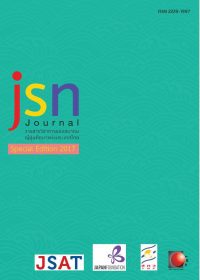Thailand–Japan Railway Cooperation: Interests and Power Competition
Main Article Content
Abstract
Railway development is Thailand’s important strategy, not only reducing logistical costs, but also developing the country’s competitiveness and quality of life. Thailand’s railway development strategy is in line with Japan’s Partnership for Quality Infrastructure, initiated by Prime Minister Shinzo Abe. This Abe’s initiative shows that Japan has emphasized its engagement with foreign countries, particularly Asian countries, in infrastructure development. Apart from Japan, China has also paid much effort to engage with foreign countries in this issue-area through both bilateral and multilateral cooperation such as Thailand-China railway cooperation and the Asian Infrastructure Investment Bank (AIIB). This research therefore examines the trajectory of Thailand-Japan railway cooperation and Japan’s interests on this cooperation. This research, which is methodologically qualitative in nature, applies Joseph Nye’s “smart power” to analyze the cases. I found that Japan would gain economic benefits from exporting Japanese products and services from its strong industries, and Japanese investors would benefit from Thailand-Japan railway projects. This research also suggests that railway cooperation is not merely a business matter, but also the power competition between Japan and China that competes each other to exert their influence on Thailand and the region.
Article Details
ข้อความและข้อคิดเห็นต่างๆ ในบทความเป็นของผู้เขียนบทความนั้นๆ ไม่ใช่ความเห็นของกองบรรณาธิการหรือของวารสาร jsn Journal
References
กระทรวงคมนาคม. (2557). ยุทธศาสตร์การพัฒนาโครงสร้างพื้นฐานด้านคมนาคมขนส่งของไทย พ.ศ. 2558-2565 และแผนปฏิบัติการด้านคมนาคมขนส่ง ระยะเร่งด่วน พ.ศ. 2558. เข้าถึงได้จาก http://www.otp.go.th/images/stories/PDF/2558/ActionPlan2558/ActionPlan3.pdf
เกรียงศักดิ์ เจริญวงศ์ศักดิ์. (2556). รถไฟความเร็วสูงในประเทศญี่ปุ่น: บทเรียนสำหรับประเทศไทย. วารสารญี่ปุ่นศึกษา, 30(1), 1–11.
คิกออฟแล้ว! รถไฟไทย–ญี่ปุ่น ทดสอบเดินรถขนส่งสินค้าจากสถานีหนองปลาดุก-บางซื่อ. (2559,5กุมภาพันธ์). เข้าถึงได้จากhttp://www.prachachat.net/news_detail.php?newsid=1454652432
ไชยวัฒน์ ค้ำชู. (2558). ญี่ปุ่นปะทะจีน: การแย่งชิงอำนาจและอิทธิพลในภูมิภาคเอเชียตะวันออก. วารสารญี่ปุ่นศึกษา, 31(2), 15-26.
ทูตไทยย้ำสัมพันธ์ไทย–ญี่ปุ่นแจ๋ว รุดหน้าความร่วมมือหลากมิติ เตรียมฉลองใหญ่ปี 2560. (2559). เข้าถึงได้จาก http://www.thansettakij.com/2016/07/09/68091
ไทย–ญี่ปุ่น ลงนามความร่วมมือระบบราง. (2555). เข้าถึงได้จากhttp://www.thairath.co.th/content/297595
พีระ เจริญพร. (2559). การลงทุนโดยตรงจากญี่ปุ่นหลังวิกฤต 40: การเปลี่ยนแปลงและนัยต่อประเทศไทย. ปทุมธานี: ศูนย์ญี่ปุ่นศึกษา มหาวิทยาลัยธรรมศาสตร์.
รถไฟไทย-ญี่ปุ่น เชื่อมการค้าทวายสู่ยุโรป คมนาคมถกเขมรปลดล็อคแลนด์ลิงก์บูมเขต ศก.พิเศษสระแก้ว. (2558). เข้าถึงได้จาก http://www.prachachat.net/news_detail.php?newsid=1431324472
เลื่อนตอกเสาเข็มรถไฟไทย-จีนเป็น มี.ค. ปีหน้า. (2559). เข้าถึงได้จาก http://www.posttoday.com/biz/gov/468422
สำนักงานคณะกรรมการพัฒนาการเศรษฐกิจและสังคมแห่งชาติ [สศช.]. (2559). ร่างแผนพัฒนาเศรษฐกิจและสังคมแห่งชาติ ฉบับที่ 12 (พ.ศ. 2560-2564). เข้าถึงได้จาก http://www.nesdb.go.th/download/content/Yearend2016/Yearend2016-00.pdf
สำนักงานคณะกรรมการส่งเสริมการลงทุน [BOI]. (2558). การลงทุนโดยตรงของญี่ปุ่นในไทยประจำปี 2557. เข้าถึงได้จาก http://www.boi.go.th/upload/content/JAP%202014_61709.pdf
สำนักงานนโยบายและแผนการขนส่งและจราจร [สนข.]. (2559). รายงานความคืบหน้าโครงการความร่วมมือรถไฟระหว่างไทย-ญี่ปุ่น. กรุงเทพฯ: สำนักงานนโยบายและแผนการขนส่งและจราจร.
Asian Development Bank [ADB]. (2013). Thailand: Supporting railway sector reform report (Consultant’s report). Retrieved from http://www.adb.org/sites/default/files/project-document/75722/46246-001-tha-tacr-01.pdf
Chan, G. (2016). China’s high-speed rail diplomacy: Global impacts and East Asian responses.Retrieved from http://www.eai.or.kr/data/bbs/eng_report/2016021517332269.pdf
Curran, E. (2015). China, Japan face off in new Asian infrastructure race. Retrieved from http://www.seattletimes.com/business/international-trade/china-japan-face-off-in-new-asian-infrastructure-race/
Drysdale, P. & Fujiwara, I. (2016). How should the world view Japan’s new economic policy strategy?. Retrieved from https://www.brookings.edu/wp-content/uploads/2016/07/TT20-australia_drysdale_fujiwara-2.pdf
Fernquest J. & Theparat, C. (2015). Japan rail projects: Somkid off to Japan to speed up work. Retrieved from http://www.bangkokpost.com/learning/work/753180/japan-rail-projects-somkid-off-to-japan-to-speed-up-work
Fernquest J. & Theparat, C. (2016). High-speed rail: Japan’s foreign minister visits Thailand. Retrieved from http://www.bangkokpost.com/learning/advanced/957849/high-speed-rail-japans-foreign-minister-visits-thailand
Holtz, M. (2016). China–Japan rivalry: Who will be Asia’s master builder?. Retrieved from http://www.csmonitor.com/World/Asia-Pacific/2016/0118/China-Japan-rivalry-Who-will-be-Asia-s-master-builder
Kishida reaffirms economic focus on Thailand. (2016). Retrieved from http://www.japantimes.co.jp/news/2016/05/02/business/kishida-reaffirms-economic-focus-thailand/#.V9kR5fCLSM_
Luft, G. (2016). China’s infrastructure play: Why Washington should accept the new Silk Road. Foreign Affairs, 95(5), 68-75. Retrieved from https://search.proquest.com/docview/1815342180?accountid=44783
Maini, T. S. (2016). Japan’s effort to counter China’s Silk Road. Retrieved from http://www.theglobalist.com/japan-effort-to-counter-china-silk-road-india/
Ministry of Foreign affairs [MOFA]. (2010). Mr. Osamu Fujimura, state secretary for foreign affairs of Japan, to attend “Mekong-Japan International Conference on East-West Economic Corridor (EWEC) and Southern Economic Corridor (SEC)”. Retrieved from http://www.mofa.go.jp/announce/announce/2010/9/0901_08.html
Ministry of Foreign affairs [MOFA]. (2015). Japan-Thailand joint press statement on the occasion of the visit by Prime Minister Prayut Chan-o-cha to Japan. Retrieved from http://www.mofa.go.jp/files/000067642.pdf
Ministry of Foreign affairs [MOFA]. (2015). Partnership for Quality Infrastructure: Investment for Asia’s future. Retrieved from http://www.mofa.go.jp/files/000081298.pdf
Ministry of Foreign affairs [MOFA]. (2016). Japan–Thailand relations. Retrieved from http://www.mofa.go.jp/region/asia-paci/thailand/archives.html
Mumbai-Ahmedabad high speed train fare to be less than airfare. (2016). India Times. Retrieved from http://timesofindia.indiatimes.com/india/Mumbai-Ahmedabad-high-speed-train-fare-to-be-less-than-airfare/articleshow/53301915.cms
Pongsudhirak, T. (2015). PM’s Japan visit heralds ‘hedging’ strategy. Retrieved from http://www.bangkokpost.com/print/481038/
Sasithorn Ongdee. (2015). Thai-Japanese rail link to Chiang Mai follows China. Retrieved from http://www.nationmultimedia.com/national/Thai-Japanese-rail-link-to-Chiang-Mai-follows-Chin-30260325.html
United Nations Conference on Trade and Development [UNCTAD]. (2015). ASEAN Investment Report 2015: Infrastructure investment and connectivity. Retrieved from http://unctad.org/en/PublicationsLibrary/unctad_asean_air2015d1.pdf
Yu Hong. (2014). China’s eagerness to export its high-speed rail expertise to ASEAN members. The Copenhagen Journal of Asian Studies, 32(2), 13-36.


